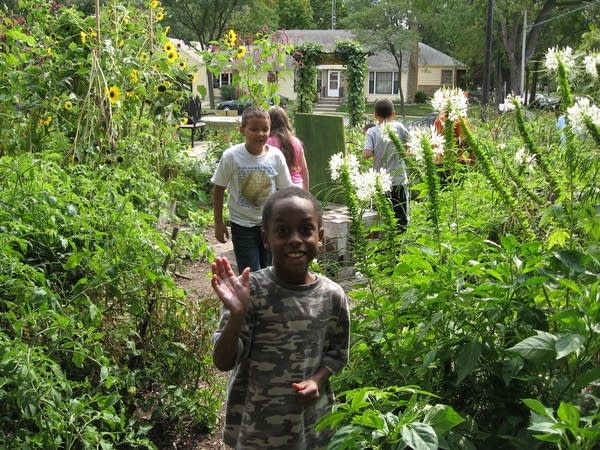Learning from the garden
Go Deeper.
Create an account or log in to save stories.
Like this?
Thanks for liking this story! We have added it to a list of your favorite stories.

Veteran teacher Michael Templeton is holding up one half of a bright yellow squash so a small group of second graders can see the seeds.
The students crowd around a picnic table piled high with fresh-picked vegetables. There are baskets of bright red tomatoes, small purple potatoes and squash of many different colors, shapes and sizes. The north Minneapolis Loring Elementary School students have come to the garden to practice what they learned, not in science class but in math -- about how to estimate.

"How many groups of 10 do you see? Two groups of 10? That's only the part that you see on top, but what if you cut it more? Would you see more seeds inside? I think you would," says Templeton, who is leading a teacher training program at the school to develop a whole range of new curricula centered around the garden.
He says having a place for students to put what they learn into action is invaluable.
Turn Up Your Support
MPR News helps you turn down the noise and build shared understanding. Turn up your support for this public resource and keep trusted journalism accessible to all.
"It's important because for any kind of learning for children it has to be relevant for them, it has to be meaningful," says Templeton. "If they are looking in the garden, they are playing in it, they are exploring and discovering new things in there and they take some kind of ownership in it, and then we pull a math lesson into that then they've already been hooked."
The school has a diverse population of about 350 students. About 80 percent receive free and reduced-price lunches.

Principal Jane Thompson says that for many of the students, the garden is their first exposure to the idea that food comes out of the ground, not just out of a box.
Second graders Eliana Branch and Kaylynn McMurtry put the benefits of using the garden as a classroom into their own words.
"I like when we get to eat the food and learn about the plants. I didn't know that bees pollinated," says Eliana.
"The bees just come from beehives to pollinate the plants," says Kaylynn.
"We have flowers and plants and apple trees," Eliana says.

This is the second full year with the garden in the schoolyard. In addition to math and science, the school is using it to teach cooking and social studies. Teachers use different kinds of vegetables from different parts of the world to help teach students about history and culture.
Joe Alfano, the elementary science coordinator for the Minneapolis public school system, says hands-on learning programs, like the one at Loring Elementary, help students meet state achievement standards.
"There is a huge set of standards around inquiry, and it definitely ties into all of that. It's a wonderful place to get kids going, and just get them observing and taking those observations and, 'What do you wonder about when you see this?' and having them start asking questions," says Alfano.

About 40 percent of Minnesota's science standard revolves around this kind of scientific inquiry.
Loring Elementary's garden was the brainchild of nearby resident Robin Krause. She and her sister lived on a farm where they grew wheat and corn and raised sheep. The experience of growing up around nature was something they wanted to share with the city kids in their neighborhood. That inspired them to start the garden.
After the estimation lesson outside, the group moves back to the classroom. Students look at a video screen showing pictures of seeds, and practice estimating how many they think are there.
School principal Jane Thompson says this symbiotic relationship between the garden and the classroom really helps kids connect with what they're taught. Thompson says the goal is to use the garden as an extension of the classroom for all subjects.






